Things You'll Need
Gloves
Silica sand, 6 to 12 pounds, depending on burner pan size
Rock wool, 6-ounce bag
Vermiculite, 6-ounce bag
Crackling ash granules, 1 to 2 pounds
Wood chips, 1/2 cup
Smoker box or empty tin can with lid or aluminum foil
Bowl
Wood-scented incense or candle (optional)

On a cold windy night, there’s only one thing better than a roaring fire, and that’s a roaring fire you can turn on and off with the flip of a switch. Such is the convenience offered by gas fireplaces today. But while they rank high for convenience, some are lacking in authenticity, especially if all they have to offer is a feeble blue flame. The good news is you can add more realism to a gas fire – tall orange flames, embers that crackle and glow, and the sweet smoky scent of burning wood – to make it seem more like a traditional wood-burning fire.
Step 1
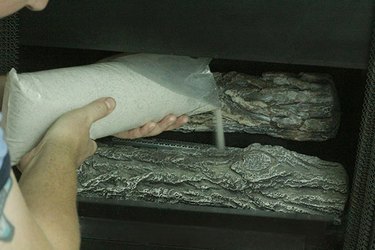
Please note these instructions are for vented gas fireplaces only, and not for use with unvented/ventless gas fireplaces.
Video of the Day
Turn the pilot light off and make sure gas supply to your fireplace is shut off by turning the key valve. If your fireplace has a grate that holds the gas logs, remove the grate as well as the logs. If it does not have a grate, leave the logs in the burner pan. Pour silica sand into the burner pan to completely cover the burner. The amount will differ depending on your burner pan size.
Step 2
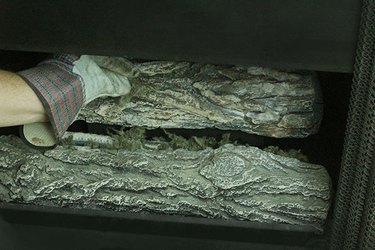
Before handling rock wool, you may want to put on gloves to avoid any possible skin irritations. Pull rock wool apart into small thumb-sized pieces and scatter on top of the silica sand in the area directly on top of the burner. Create a generous pile of rock wool pieces over the burner. The rock wool will act as the bed of glowing embers and must be in direct contact with the flames in order to glow.
Step 3
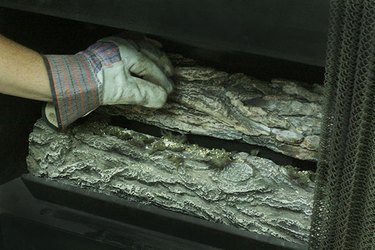
Sprinkle a handful of vermiculite, about 1/2 cup, over the rock wool. Be sure to concentrate it directly over the burner. If you took the grate and logs out, set the grate back into the burner pan on top of the silica sand, rock wool and vermiculite. Put the gas logs back onto the grate.
Step 4
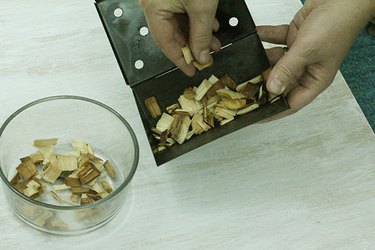
Soak 1/2 cup of wood chips in a bowl of water for 30 minutes to an hour. Drain and place wood chips in smoker box. If using an empty tin can instead of a smoker box, place wood chips inside tin can and cover with lid or aluminum foil. Poke holes in the lid or foil to allow smoke to escape.
Step 5
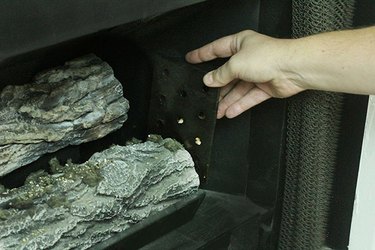
Place smoker box or tin can in the fireplace where it won't be conspicuous, either on the sides or in the back. It doesn't need to be in direct contact with the flames, but it needs to be close enough to be heated in order to release a wood-smoke scent. The wood chips will need to be replaced by freshly soaked chips for each fire.
Optional: You can also light a wood-scented incense stick or candle and place on the mantel if you don't want to use a smoker box indoors. Some candles even come with wood wicks, which add to the crackling sound.
Step 6
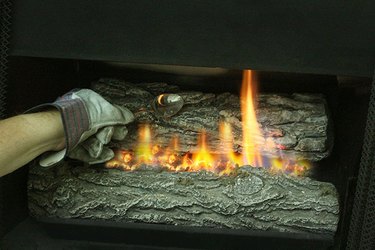
Turn gas valve back on and reignite the pilot light. Turn fireplace on to see where flames will hit the embers and logs. Take 1 to 2 tablespoons of crackling ash granules and sprinkle directly over where the flames will hit. The granules must be in direct contact with the flames in order to crackle and pop. Close the doors or curtain to the fireplace to keep the crackling embers from popping out onto the floor. Whenever the popping and crackling sounds run out, add another spoonful of crackling ash granules onto the fire.
Step 7
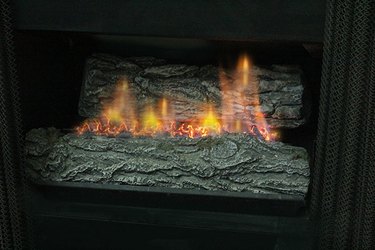
Enjoy the striking realism of your gas fireplace. The flames should be taller and have an orange color. The rock wool will begin to glow orange immediately, as long as it's in direct contact with the flames. A smoky wood scent will be noticeable and the crackling ash granules will start to pop after approximately 15 to 20 minutes.
Tip
If your fireplace uses propane gas instead of natural gas, do not use silica sand to cover the burner. Use vermiculite instead. You can find rock wool, silica sand, vermiculite and crackling ash granules at a fireplace supply store or order online. You may need to turn the fireplace off and shift the rock wool around until it resembles a realistic pile of embers. You can also find electronic fireplace sound boxes that produce crackling ember sound effects, which you can set on the mantel or near the fireplace. The silica sand, rock wool and vermiculite should last for many years, but will gradually lose their effect.
Warning
These materials are only for use with vented gas fireplaces – NOT for use with unvented/ventless gas fireplaces. Don't set the smoker box or tin can directly on the logs to avoid damaging the logs. Wear heat-resistant gloves when handling gas logs and only handle when cool. You may want to wear a mask when handling these materials to avoid upper-respiratory irritations. Never add real wood logs to a gas fireplace. Never leave your fireplace unattended while burning.
Video of the Day